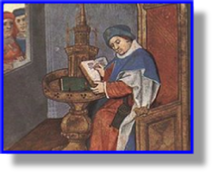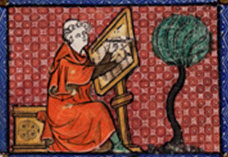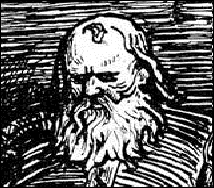


GUILLAUME DE LORRIS 1225 (H3)
Including:
Jean de
Meun

xxxxxThe first part of the allegorical poem Romance of the Rose, a story of courtly love, was written by the French poet Guillaume de Lorris around 1225. He tells the idyllic love theme with great feeling and delicacy. The poem was completed some 40 years later by his fellow countryman Jean de Meun, but, as befitting a different age, his contribution has nothing of the poem’s earlier charm. It tends to be cynical in tone and concerned for the most part with a vast range of contemporary topics, some controversial. It is to these lengthy digressions that the work now owes its success. The English poet Geoffrey Chaucer translated part of the poem and was clearly influenced by its style and content.
 xxxxxGuillaume de Lorris was the French poet who wrote the first section, some 4,000 lines, of the popular allegorical poem known as the Roman de la Rose (Romance of the Rose) -
xxxxxGuillaume de Lorris was the French poet who wrote the first section, some 4,000 lines, of the popular allegorical poem known as the Roman de la Rose (Romance of the Rose) -
 xxxxxIn these opening lines, he shows the charm and sensitivity one associates with traditional courtly love. The idyllic love theme is presented as a dream, and the delicacy of his treatment is in marked contrast to the remainder of the poem, completed some 60 years later by the French poet Jean de Meun. His addition of more than 17,000 lines reveals a different approach for a different age. Idealism now gives way to cynicism, and the theme's finer feelings are overwhelmed by a mass of information and opinion on a vast range of contemporary topics, many of them controversial. And it is to these down-
xxxxxIn these opening lines, he shows the charm and sensitivity one associates with traditional courtly love. The idyllic love theme is presented as a dream, and the delicacy of his treatment is in marked contrast to the remainder of the poem, completed some 60 years later by the French poet Jean de Meun. His addition of more than 17,000 lines reveals a different approach for a different age. Idealism now gives way to cynicism, and the theme's finer feelings are overwhelmed by a mass of information and opinion on a vast range of contemporary topics, many of them controversial. And it is to these down-
xxxxxIncidentally, Geoffrey Chaucer translated over 1,000 lines of Roman de la Rose into English. The poem is said to have had an important influence on his writing. ……
 xxxxx…… Belonging to this period, dated around 1222, was the epic Prose Edda, the work of the Icelandic poet and historian Snorri Sturluson (1179-
xxxxx…… Belonging to this period, dated around 1222, was the epic Prose Edda, the work of the Icelandic poet and historian Snorri Sturluson (1179-
H3-
Acknowledgements
Guillaume: a miniature from a manuscript of The Roman de la Rose, artist unknown – Bodleian Library, Oxford. Jean: from a French manuscript of The Roman de la Rose, artist unknown, c1340. Sturluson: detail by the Norwegian artist Christian Krohg (1852-


